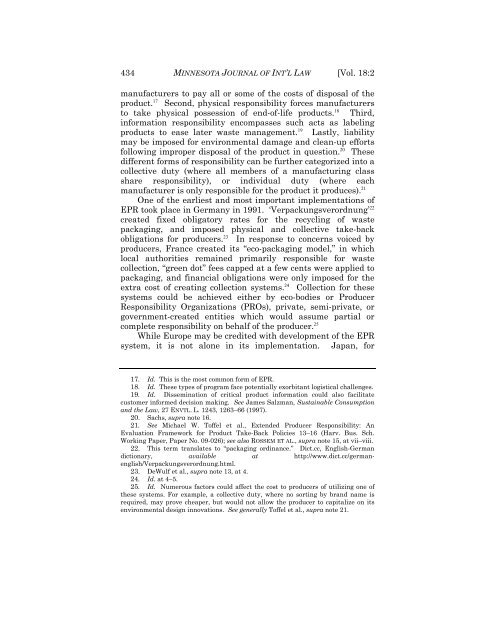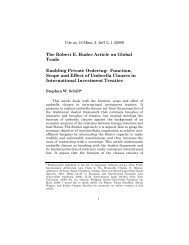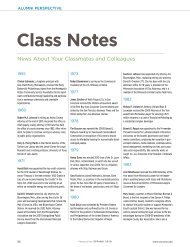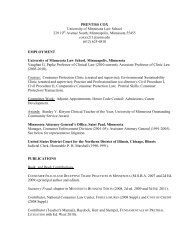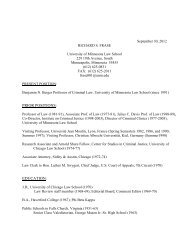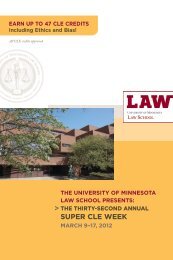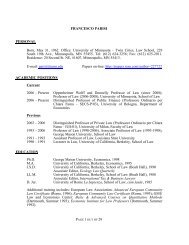The End-of-Life Vehicle (ELV) - the University of Minnesota Law ...
The End-of-Life Vehicle (ELV) - the University of Minnesota Law ...
The End-of-Life Vehicle (ELV) - the University of Minnesota Law ...
Create successful ePaper yourself
Turn your PDF publications into a flip-book with our unique Google optimized e-Paper software.
434 MINNESOTA JOURNAL OF INT’L LAW [Vol. 18:2<br />
manufacturers to pay all or some <strong>of</strong> <strong>the</strong> costs <strong>of</strong> disposal <strong>of</strong> <strong>the</strong><br />
product. 17 Second, physical responsibility forces manufacturers<br />
to take physical possession <strong>of</strong> end-<strong>of</strong>-life products. 18 Third,<br />
information responsibility encompasses such acts as labeling<br />
products to ease later waste management. 19 Lastly, liability<br />
may be imposed for environmental damage and clean-up efforts<br />
following improper disposal <strong>of</strong> <strong>the</strong> product in question. 20 <strong>The</strong>se<br />
different forms <strong>of</strong> responsibility can be fur<strong>the</strong>r categorized into a<br />
collective duty (where all members <strong>of</strong> a manufacturing class<br />
share responsibility), or individual duty (where each<br />
manufacturer is only responsible for <strong>the</strong> product it produces). 21<br />
One <strong>of</strong> <strong>the</strong> earliest and most important implementations <strong>of</strong><br />
EPR took place in Germany in 1991. ‘Verpackungsverordnung’ 22<br />
created fixed obligatory rates for <strong>the</strong> recycling <strong>of</strong> waste<br />
packaging, and imposed physical and collective take-back<br />
obligations for producers. 23 In response to concerns voiced by<br />
producers, France created its “eco-packaging model,” in which<br />
local authorities remained primarily responsible for waste<br />
collection, “green dot” fees capped at a few cents were applied to<br />
packaging, and financial obligations were only imposed for <strong>the</strong><br />
extra cost <strong>of</strong> creating collection systems. 24 Collection for <strong>the</strong>se<br />
systems could be achieved ei<strong>the</strong>r by eco-bodies or Producer<br />
Responsibility Organizations (PROs), private, semi-private, or<br />
government-created entities which would assume partial or<br />
complete responsibility on behalf <strong>of</strong> <strong>the</strong> producer. 25<br />
While Europe may be credited with development <strong>of</strong> <strong>the</strong> EPR<br />
system, it is not alone in its implementation. Japan, for<br />
17. Id. This is <strong>the</strong> most common form <strong>of</strong> EPR.<br />
18. Id. <strong>The</strong>se types <strong>of</strong> program face potentially exorbitant logistical challenges.<br />
19. Id. Dissemination <strong>of</strong> critical product information could also facilitate<br />
customer informed decision making. See James Salzman, Sustainable Consumption<br />
and <strong>the</strong> <strong>Law</strong>, 27 ENVTL. L. 1243, 1263–66 (1997).<br />
20. Sachs, supra note 16.<br />
21. See Michael W. T<strong>of</strong>fel et al., Extended Producer Responsibility: An<br />
Evaluation Framework for Product Take-Back Policies 13–16 (Harv. Bus. Sch.<br />
Working Paper, Paper No. 09-026); see also ROSSEM ET AL., supra note 15, at vii–viii.<br />
22. This term translates to “packaging ordinance.” Dict.cc, English-German<br />
dictionary, available at http://www.dict.cc/germanenglish/Verpackungsverordnung.html.<br />
23. DeWulf et al., supra note 13, at 4.<br />
24. Id. at 4–5.<br />
25. Id. Numerous factors could affect <strong>the</strong> cost to producers <strong>of</strong> utilizing one <strong>of</strong><br />
<strong>the</strong>se systems. For example, a collective duty, where no sorting by brand name is<br />
required, may prove cheaper, but would not allow <strong>the</strong> producer to capitalize on its<br />
environmental design innovations. See generally T<strong>of</strong>fel et al., supra note 21.


